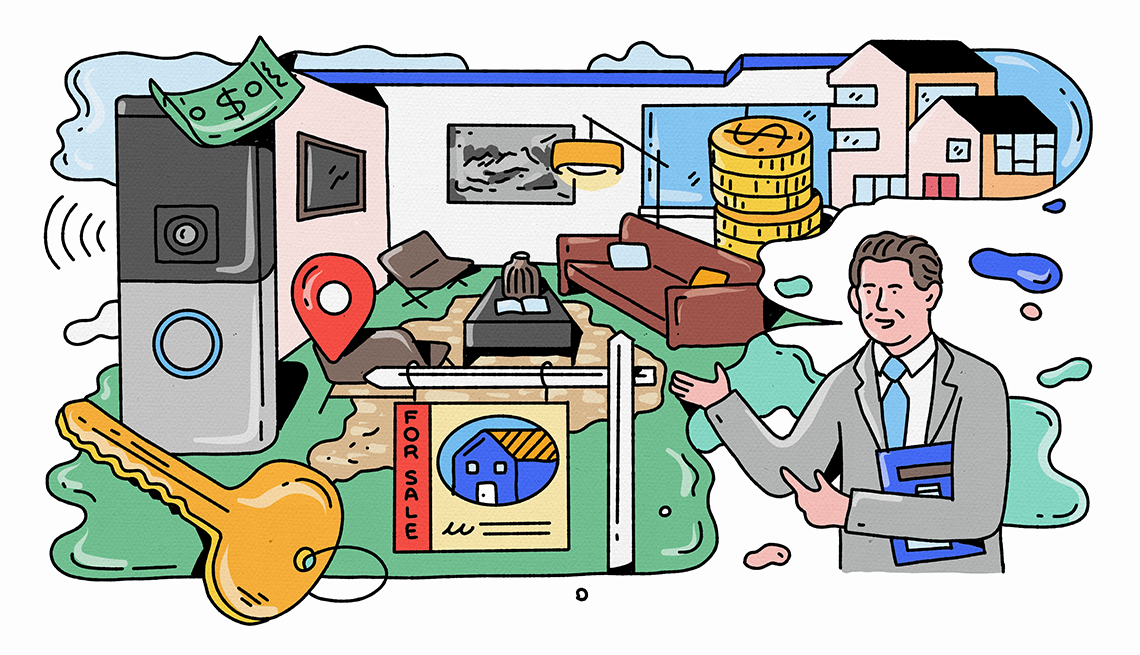AARP Hearing Center


Anyone who thinks older adults aren’t active in today’s real estate market hasn’t been paying attention. According to a 2024 report from the National Association of Realtors, people over 55 make up the most active group of home sellers, with boomers leading the way.
We know it can be overwhelming if it’s been years (and possibly decades) since you bought or sold a house. Whether you’re trying to understand how the real estate market has changed or protect yourself from scammers targeting older adults, it’s easy to feel like you’re in over your head.
Realtor Jeff Lichtenstein is here to help. He’s the president and broker of Echo Fine Properties in Palm Beach Gardens, Florida, and the author of the business leadership book How Making a Sandwich Can Change Your World: The Amazing Success of the PB&J Strategy. Before you list your home or start your search for the perfect next abode, he shares some tips and tricks — in his own words — that’ll make your real estate experience less nerve-wracking.
FOR BUYERS
Choose the neighborhood first, not the house
People get fixated on house details right off the bat when they should begin by picturing their ideal neighborhood. There are so many factors to consider: How far are you from a grocery store or an airport? What about schools? Being near a school can help your resale value (especially if it’s a good school), but it also means loud kids, extra foot traffic and school bus gridlock. You need a neighborhood that works for your life today, not just what looks good on paper.
For many older adults, proximity to a hospital is important. I was talking to a client yesterday, and he wanted to prioritize homes that were the shortest drive to a hospital. Not because he was in poor health, but at his age (over 60), he wanted the peace of mind in knowing that if he did have a heart attack, he wouldn’t, in his words, “die in the back of an ambulance because I live too far away.” Drive or walk around the area to get a better feel.
Buy when you are truly ready to do so
Buying a house can be a little dizzying, especially when everybody has an opinion about strategy. Some will tell you to wait for interest rates to drop, and others will insist that with the inventories low you have to pounce as soon as possible for a house that fits your requirements.
To some extent, they’re all correct. But the best time is when you’re financially ready to do it. My son is living at home right now and saving money to buy his first home. If he were too eager, he’d buy something today and stretch his resources. But instead, he’s taking his time with it, saving up so he’s not cash-poor when he does eventually buy and not letting other factors cloud his judgment.
Don’t worry about your “perfect house” slipping away. There’ll be more perfect houses waiting for you tomorrow or next year.
Don’t put too much stock in the neighbors
I see a lot of hand-wringing from buyers over whether they’ll get along with their neighbors. I think it’s a good idea to talk to the people you’ll be living next to to get a sense of the community vibe. And they can be a great source of intel on everything from grocery stores to trash day. But don’t let them weigh too heavily on your decision. Neighbors come and go. I’ve lived in my house for 23 years, and nobody who was on my block when I first moved in is still around. On our first day there, the guy who lived across the street walked over just to tell me he graduated from Harvard and how smart he was. I couldn’t stand him. But he moved out in a week.
Ask yourself if nearby vacation rentals would bug you
Short-term vacation homes in the neighborhood from Airbnb, craigslist, Expedia, FlipKey, HomeAway, TripAdvisor and Vrbo can increase a home’s resale value. One study found that a 1 percent increase in Airbnb listings can lead to a 0.026 percent increase in house prices in the same neighborhood. This is great news if you’re buying a house solely as an investment. But if you intend to live there, you could be living next to a carousel of new renters, most of whom are in “vacation mode.” Some apps, like Mashvisor, let you search not just for Airbnb rentals in your area but also the demand.


































































You Might Also Like
Denise Richards Lives Life With No Regrets
Acress says media negativity taught her ‘to always be myself’
Can I Share Movies, TV Shows, Other Content With a Parent or Grandparent?
Apple and Google have family sharing plans that may save your loved one some money
AARP Smart Guide to Decluttering
39 strategies on how to donate, ditch and downsize the things filling up your home